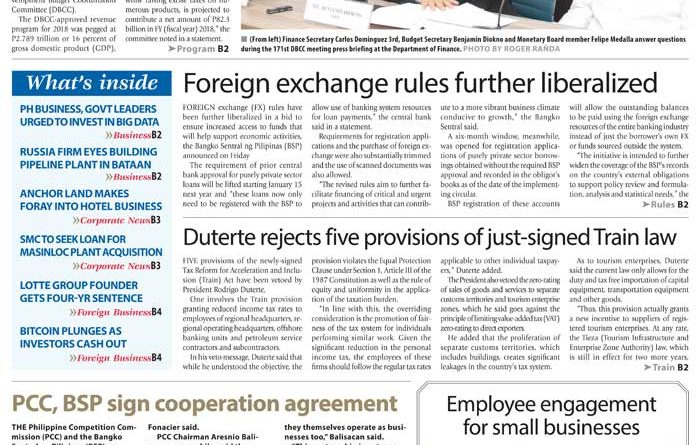MANILA: ECONOMY – Economic managers cut revenue program for 2018
Economic managers on Friday trimmed the government’s revenue program for next year on account of lower-than-expected proceeds from the newly-signed Tax Reform for Acceleration and Inclusion (Train) Act.

(From left) Finance Secretary Carlos Dominguez 3rd, Budget Secretary Benjamin Diokno and Monetary Board member Felipe Medalla answer questions during the 171st DBCC meeting press briefing at the Department of Finance. PHOTO BY ROGER RAÑDA
.
Economic growth and inflation targets were retained but other macroeconomic indicators were revised by the interagency Development Budget Coordination Committee (DBCC).
The DBCC-approved revenue program for 2018 was pegged at P2.789 trillion or 16 percent of gross domestic product (GDP), lower than the previous P2.841 trillion.
“The first package of Train, which lowers personal income tax rates while raising excise taxes on numerous products, is projected to contribute a net amount of P82.3 billion in FY (fiscal year) 2018,” the committee noted in a statement.
– ADVERTISEMENT: This space is reserve for your Ad, contact aseanews.net now! –
During the last DBCC meeting in June, economic managers estimated that the government’s first tax reform package would contribute P133.8 billion next year, P233.6 billion in 2019, P272.9 billion in 2020, P253.0 billion in 2021 and P269.9 billion in 2022.
The final tally will likely be slightly higher given line item vetoes by President Rodrigo Duterte. A Cabinet official also said revenues could increase with fresh tax reforms expected to be passed by Congress in the first quarter of next year.
“Actually with the veto, we estimate the revenues will go up close to P90 billion; that is only for Train 1A. Part B is estimated to have a net revenue of P48 or P40 billion. We expect that passed by the first quarter,” Finance Secretary Carlos Dominguez 3rd said in a briefing.
By 2022, revenues are expected to rise to P4.388 trillion or 17.3 percent of GDP.
The DBCC-approved disbursement target, meanwhile, was set at P3.313 trillion for 2018, rising to P5.149 trillion in 2022.
With respect to the deficit, the interagency body retained the 3 percent of GDP ceiling.
The financing mix will also continue to favor domestic borrowings but for 2018 there was a slight adjustment as the government is projected to borrow 74 percent from domestic sources and 26 percent from foreign sources.
For 2019 to 2022, the borrowing program is projected to follow an 80-20 mix, still in favor of domestic sources.
The national government debt ratio is also projected to continue its downward trajectory from 42 percent in 2017 to 37.9 percent in 2022.
“The medium-term fiscal program is geared to support the development objectives of the Duterte Administration,” Budget Secretary Benjamin Diokno said.
“We will ensure that all the revenues collected and monies disbursed will be for the benefit of our people,” he added.
Economic managers kept the official GDP target for next year until 2022 at 7-8 percent.
“We think we are doing well … we didn’t find a need to change much of our assumptions until 2022,” Diokno said.
Inflation goals were also kept at 2-4 percent for 2018 to 2022 but peso-dollar exchange rate assumptions were tweaked.
“We changed it to P49 to P52 per US dollar. This adjustment, however, should not be a cause of concern because as you know the impact in this in our fiscal position. A peso depreciation is actually favorable to our fiscal position,” Diokno said.
The DBCC’s previous assumption was an exchange rate of P48-P51 per dollar for 2018 to 2022.
Higher export growth, meanwhile, is expected next year with the estimate raised to 9 percent from 7 percent. For 2019 to 2022, the outlook is 9 percent exports growth.
Dubai crude is expected to hit $50 to $65 per barrel next year. The same range was also forecast for 2019 to 2022.
COURTESY:
BUSINESS TIMES
BY MAYVELIN U. CARABALLO, TMT
ON
NOTE : All photographs, news, editorials, opinions, information, data, others have been taken from the Internet ..aseanews.net | [email protected] |
For comments, Email to :
Pahulu Gan – Contributor | [email protected]









